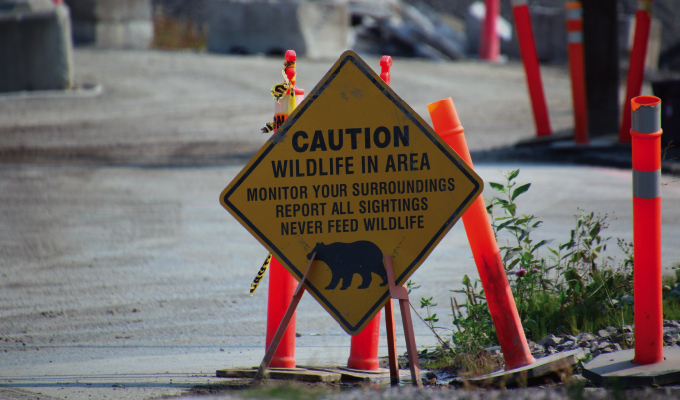I remember getting a call one day from my safety director who was working with our crew in Texas. His exact words to me were, “Boss, if the boar charges us, I’m going to shoot it. Just saying.” And then the phone went dead. Seriously? When I finally got him back on the phone, he told me the boar was not bothering them right now, so they were going to leave him alone. Encouragement to move him with a forklift did not deter this grand creature. He kept coming back. I spent many hours hoping that stupid boar would leave the crew alone.
CALL OF THE WILD
I used to think that crews going to sites only had to worry about standard construction safety. You know, fall protection, PPE, RF, rigging, etc. I have come to realize that these fabulous men and women in the field get to work around some of the most unbelievable wildlife, every day. Some good. Some not so good. HOLY COW!!! Literally, even a cow.
The reality is: crews, who already face hundreds of hazards just by working outdoors, are also at risk for becoming injured or ill due to contact with wildlife. Dangerous animals come in all sizes. Bears, groundhogs, raccoons, opossums, birds, deer, feral cats, rodents, foxes, coyotes, ticks, mosquitos, bees, wasps, spiders, and snakes. All the crews that I have been so blessed to work with and am in support of, can attest to seeing almost all the animals listed. Did I mention alligators?
Many times, encounters are harmless. But any animal, even gentle deer, can become dangerous if they are frightened, have young to protect, are in mating season, or if they are injured or ill. Some of these creatures, ticks and mosquitos, bite because that is their very nature. However an encounter ensues, the results can be serious or even deadly for our crews.
DETER FROM SITE
I’ve seen articles written about pre-stressing. It’s a term used to describe actions taken to encourage wildlife to move away from a site prior to the onset of construction. Common methods of pre-stressing include having one or more people walk the site while talking loudly or playing loud music or placing pieces of cloth or other object that carry a strong human scent into animal dens. To be effective, these measures may need to be combined and repeated several times over the course of 2 to 3 weeks.
I hate to say this—but this doesn’t always work. Alligators in Florida just seem to move “closer,” not farther away.
PROTECTION MEASURES
All personnel should be briefed about wildlife protection measures at the outset of any project. The briefing needs to provide an overview of the mitigation measures that are being used at the site, as well as instruction on what to do if, and when wildlife is encountered during the work. Common attractants on a jobsite should be controlled or eliminated:
- Food; wastes and garbage
- Water: supply drainage to limit standing pools, fence off temporary storm ponds or waterbodies
- Shelter: cover/contain piles of soil, fill, brush, rocks, and loose materials; cap ends of pipes; ensure trailers, bins, boxes, and vacant buildings are secured every day to prevent access by wildlife
There could be species at risk in the area of your construction site and basic identification tips and recommendations need to be outlined to save protected species. Do not harm, feed or unnecessarily harass wildlife. Any wildlife encountered during site clearing or subsequent construction activities should be allowed to exit the site on their own, via safe routes. Crews should not attempt to capture or handle most kinds of wildlife. Scratches and bites from animals, whether domestic or wild, can result in serious infections and/or transmit diseases. Immediate medical treatment should be sought for any person injured by an animal.
INJURIES AND ILLNESSES
Bite Wounds: Many animals are naturally equipped with a powerful bite and sharp teeth which are literally designed to tear flesh and break bones.
Infections: Treat a bite wound immediately. Animals’ mouths harbor hundreds of forms of bacteria which is transferred into the bite wound.
Lyme Disease: Carried by ticks. Most are aware of the existence of Lyme disease but don’t know how serious it can be.
Rocky Mountain Spotted Fever: This disease is also spread by ticks and symptoms include rash, fever, muscle pain, and confusion.
Rabies: Spread through an animal bite; deadly
Envenomation: Venomous snakes and insects can inject venom which can be deadly or do significant damage to the tissue surrounding the bite. Are you sure you know, without a doubt, all 3,400 species of snakes and you know which one is on your jobsite?
CLOSING THOUGHT
Be safe. Educate yourself on wildlife in the area where you are working. ALWAYS, be prepared for the unexpected visitor.
About the Author:
Kathy Stieler is the director of safety, health & compliance for NATE: The Communications Infrastructure Contractors Association. She can be reached at 812.204.8832 or kathy@natehome.com.
Modern Contractor Solutions, March 2022
Did you enjoy this article?
Subscribe to the FREE Digital Edition of Modern Contractor Solutions magazine.



